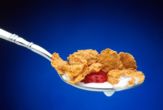Free Food: Packaging Labels Contain Errors

Consumers are either getting ripped off or eating free food when they buy certain products. According to recent study, the labels on a sampling of single serving foods reported their true weight only about a third of the time.
Free food might sound like a bonus, but scientists say that for people with chronic conditions or diseases, excess food could add to their diet difficulties.
"Our results show that people with diabetes, or others who are trying to precisely control their diet should weigh their own food and not rely on the labels," Joan Conway, a research chemist with the USDA, told LiveScience.
In the interest of efficiency in her own studies of diet and lifestyle, Conway and her colleagues tested 99 single-serving foods to find out if the amount printed on the package was the amount of food inside.
"We thought if we could use pre-packaged foods in our own studies, it would save us a lot of time," Conway said.
The study, detailed in the Journal of the American Dietetic Association, found 37 labels were accurate, 15 were underweight, and 47 were overweight.
Although federal regulations say most of the foods tested can vary by no more than 10 percent, many of the food labels had much greater discrepancies.
Sign up for the Live Science daily newsletter now
Get the world’s most fascinating discoveries delivered straight to your inbox.
Breakfast cereals, slices of bread, and pre-packaged breakfast items were three of the heaviest groups, varying by as much as 72 percent of what their labels reported. That is an excess of as many as 100 calories.
Lightweight foods, pre-cooked bacon and bologna missed their mark by as much as 25 percent.
"It is the responsibility of the companies to have truth in advertising," Conway said. "The FDA does random testing and the National Institute of Standards and Technology sets how much a food can fall above or below the amount it is said to contain, but there is not a lot of oversight."









